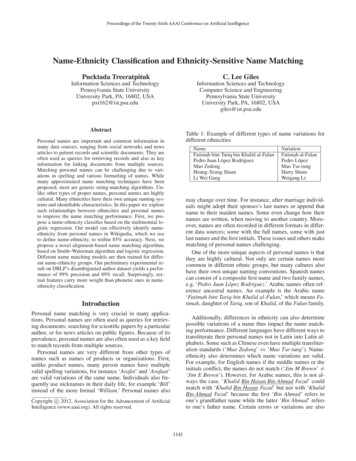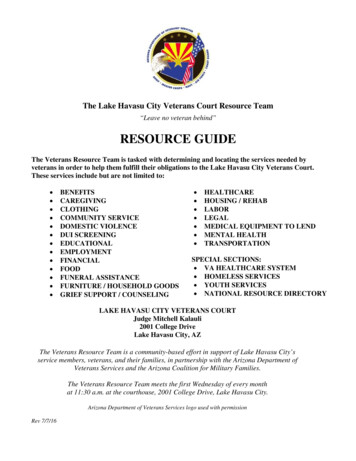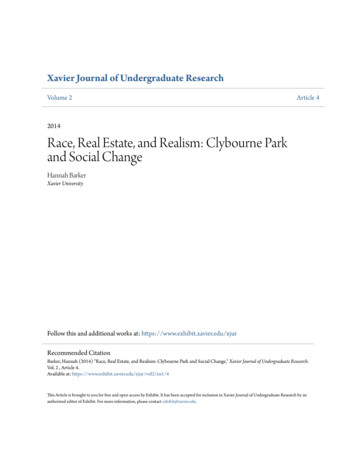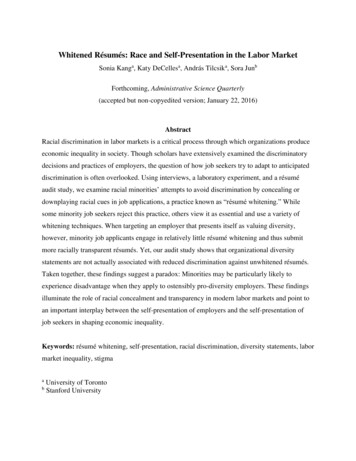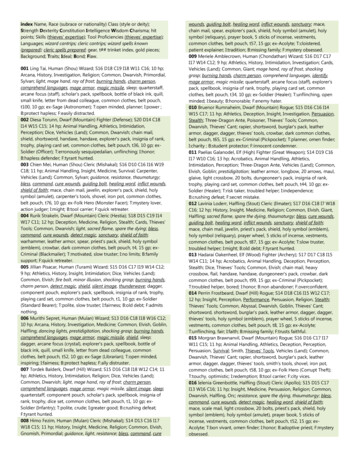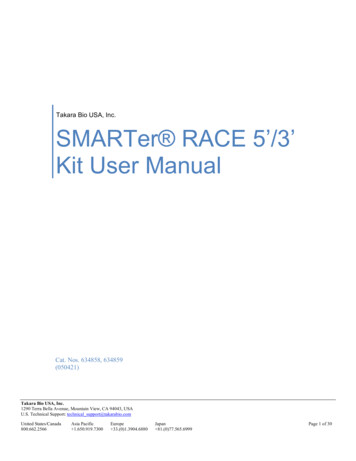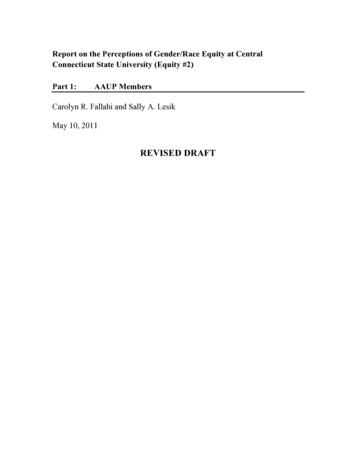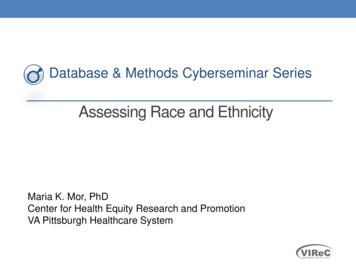
Transcription
Database & Methods Cyberseminar SeriesAssessing Race and EthnicityMaria K. Mor, PhDCenter for Health Equity Research and PromotionVA Pittsburgh Healthcare System
2Database & Methods Cyberseminar SeriesInformational seminars to help VA researchersunderstand how to use VA and non-VA data in researchand quality improvementTopics Application of VA and non-VA data to research and qualityimprovement questions Limitations of secondary data use Resources to support VA data use3/2017
FY ‘17 Database & Methods ScheduleFirst Monday of the month* 1:00pm-2:00pm ETSelect a link to viewarchivedcyberseminars.Visit VIReC’sCyberseminar pagefor more informationand to register forupcoming Overview of VA Data & Research Uses11/7/2016Requesting Access to VA Data12/5/2016Healthcare Utilization with MedSAS & CDW1/9/2017VA Medicare Data (VA/CMS)2/6/2017Assessing Outpatient Utilization with VA Data3/6/2017Mortality Ascertainment & Cause of Death4/3/2017Assessing Race & Ethnicity6/5/2017Pharmacy Data7/10/2017*CAPRI/VistAWeb for EHR Access8/7/2017Comorbidity Measures Using VA and CMS Data8/21/2017Advanced Topics in Comorbidity Measures9/11/2017*CDW microbiology, lab, & pharmacy domains*Schedule shifts by one week in event of VA holiday.3/2017
4Database & Methods Cyberseminar SeriesAssessing Race and EthnicityMaria K. Mor, PhDCenter for Health Equity Research and PromotionVA Pittsburgh Healthcare System3/2017
5By the end of this session, attendees will be able to: Locate race and ethnicity in VA and Medicare data Assess the quality of VA race and ethnicity data Create SQL code to use race and ethnicity data3/2017
6Session Outline Introduction Locating race and ethnicity in VA data Locating race and ethnicity in Medicare/Medicaid Quality of VA race/ethnicity data Examples Recommendations to address data quality issues Where to go for more help3/2017
7Session Outline Introduction Locating race and ethnicity in VA data Locating race and ethnicity in Medicare/Medicaid Quality of VA race/ethnicity data Examples Recommendations to address data quality issues Where to go for more help3/2017
8Poll Question #1I am interested in VA data primarily due to my role as:a.Principal investigator/Co-PIb.Research staff (Project coordinator, data manager,programmer)c.Clinical Staffd.Operations Staffe.Other—Please describe via the Q & A function3/2017
9Poll Question #2:Have you ever used VA Race/Ethnicity Data? Yes No3/2017
10Introduction Racial/ethnic disparities in health and health care are well-documented and persistent in the US Root causes and solutions are not well understood Most minorities groups experience negative disparities in Access andQuality of care (AHRQ 2016) Racial/ethnic disparities also exist in VHA, where financialbarriers to receiving care are minimized Although quality has improved, significant within-facility disparitiesobserved in clinical outcomes (Trivedi 2011) More research to detect, understand, and address disparities inhealth and health care is needed3/2017
11Introduction Accurate race/ethnicity data are essential to disparitiesresearch and research on clinical factors associated withrace/ethnicity Problems with race/ethnicity data in the VA Incomplete Inaccuracies Inconsistent over time3/2017
12Racial/Ethnic Distribution of Veterans Approximately 78% of all Veterans are White 0.6% American Indian or Alaska Native 1.6% Asian 11.2% Black 6.6% Hispanic 1.4% Two or more races Use of VA health care differs by race Asian Veterans less likely to use (25.4 %) Black, AIAN, 2 races more likely to use ( 36%) National Center for Veterans Analysis and Statistics 2014 Minority Report3/2017
13VA Race and Ethnicity CategoriesVHA Handbook 1601A.01 (2009) Ethnicity Spanish, Hispanic, or Latino Race ( 1 may be selected) American Indian or Alaska Native Asian Black or African American Native Hawaiian or Other Pacific Islander White Unknown by Patient Current reporting method 2 question format: ethnicity, race Self-reported3/2017
14Acquisition of Race/Ethnicity Data in VHA How Patient (self-report) Proxy VHA Enrollment Coordinator or clerk When VA Form 10-10EZ Application for Health Benefits (on-line, paper,interview) Inpatient or outpatient visit to VHA facility Data are entered directly into VistA3/2017
15Session Outline Introduction Locating race and ethnicity in VA data Locating race and ethnicity in Medicare/Medicaid Quality of VA race/ethnicity data Examples Recommendations to address data quality issues Where to go for more help3/2017
16Poll Question #3:What sources of VA race/ethnicity data have you used ?(check all that apply) Never used race/ethnicity data CDW MedSAS files VistA or regional warehouse Other VA data sources3/2017
17Sources of Race and Ethnicity Data in VAMedical SAS DatasetsVariable NameRACEMedSAS DatasetDescriptionInpatient (PTF Main File)FY 1976 - presentOutpatient (Visit File)FY 1997 - presentOutpatient (Event File)FY 1998 - presentRACE1-RACE6Inpatient (PTF Main)FY 2003 - presentRACE1-RACE7Outpatient (Visit, Event)FY 2004 - presentETHNICInpatient (PTF Main)FY 2003 - presentOutpatient (Visit, Event)FY 2004 - present3/2017
18Race/Ethnicity Variables in MedSAS Prior to FY 2003 Race and ethnicity captured jointly in the variable RACE Single value allowed for race/ethnicity After FY 2003 Multiple races captured in RACE1-RACE7 Single value for ethnicity captured in ETHNIC RACE1-RACE7 and ETHNIC have a length of 2 characters First character has race or ethnicity Second character has method of data collection Common format used for method of data collection3/2017
19Medical SAS Datasets: Race/Ethnicity Values(Pre-2003)RACE: Single value for race and ethnicityValueDescription1Hispanic, white2Hispanic, black3American Indian4Black5Asian6White7 or missingUnknown3/2017
20Medical SAS Datasets:Race Values (Post-2003) RACE1-RACE7 : Race and method of data collection The first character specifies race1st CharacterDescription3American Indian Or Alaska Native8Asian9Black or African AmericanANative Hawaiian or Other Pacific IslanderBWhiteCDeclined to AnswerDUnknown(blank)Missing3/2017
21Medical SAS Datasets: Ethnicity Values(Post-2003) ETHNIC: Ethnicity and method of data collection The first character captures ethnicity1st CharacterDescriptionDDeclined To AnswerHHispanic or LatinoNNot Hispanic or LatinoUUnknown(blank)Missing3/2017
22Medical SAS Datasets: Race and EthnicitySource (Post-2003) RACE1-RACE7, ETHNIC The second character specifies method of data collection2nd Self-identificationUUnknown By Patient3/2017
23Corporate Data Warehouse (CDW) National repository of data from VistA Patient File with race and ethnicity datafrom October 1999 to present Contains 1 demographic record for each VA station a Veteran has visited Contains standard and nonstandard race values Racial data available in 2 views PatSub.PatientRace (newer collection standards) SPatient.SPatient or Patient.Patient (older collection standards) Use both views to obtain all available race dataReferenceBest Practices Guide: Race Data (Data Quality s/0/DataQualityProgram/Reports/Best Practices Guide Race Data.pdf (VA Intranet only)3/2017
24Race Tables in CDW PatSub.PatientRace RACE contains patient race COLLECTIONMETHOD contains method of data collection Patient/STA3N level Most recent data available for the patient Multiple records if more than one race identified SPatient.SPatient or Patient.Patient RACESID contains the SID for the patient race Link to CDWWork.Dim.Race to map to race Contains race data collected under the old collection methods Does not allow for multiple races3/2017
25Non-standard Race Values in CDW26 of 31 non-standard races can be mapped to 4 standard racesExamplesNon-standard RaceAMER INDIAN OR ALASKAN NATIVE, AMERICANINDIAN, AMERICAN INDIAN / ALASKAN NATIVEBLACK; BLACK NOT OF HISP ORIG; BLACK,NON HISPANIC; HISPANIC BLACKWHITE NOT OF HISP ORIG; WHITE, NOTHISPANIC; HISPANIC WHITE; CAUCASIAN;PACIFIC ISLANDERStandard RaceAMERICAN INDIAN ORALASKA NATIVEBLACK OR AFRICANAMERICANWHITENATIVE HAWAIIAN OROTHER PACIFIC ISLANDER Non-standard values rarely used in PatSub.PatientRace ( 1%) Standard values rarely used in SPatient.SPatient/Patient.Patient ( 1%)3/2017
26Non-Mapped Values (CDW) 5 values are not mapped to standard values ASIAN OR PACIFIC ISLANDER ASIAN PACIFIC ISLANDER ASIAN/PACIFIC ISLANDER MEXICAN AMERICAN UNKNOWN 4.6% of data fall into 1 of these 5 categories (2012)3/2017
27Multiple Race Values (CDW) Approximately 1.7% of patients linked to a standard race have more than 1standard race (2013) Not possible to identify the most recent record for a patient Recommendation for multiple values Use only self-identified races, if any are recorded Use all recorded races for patients without self-identified raceReferenceCDW Race Data and Multiple Races (Data Quality s/0/DataQualityProgram/Reports/CDW Race Data and Multiple Races.pdf (VA Intranet only)3/2017
28Ethnicity (CDW) Ethnicity found in 3 CDW tables PatSub.PatientEthnicity – new method ‘HISPANIC OR LATINO ‘NOT HISPANIC OR LATINO’ PatSub.PatientRace or SPatient.SPatient/Patient.Patient Hispanic race/ethnicity (e.g., HISPANIC, WHITE; HISPANIC, BLACK) Non Hispanic race/ethnicity (e.g., WHITE NOT OF HISP ORIG;BLACK NOT OF HISP ORIG) Not all race/ethnicity values indicate ethnicity (e.g., ASIAN, BLACK)ReferenceCDW Ethnicity Data (Data Quality s/0/DataQualityProgram/Reports/CDW Ethnicity Data.pdf (VA Intranet only)3/2017
29Session Outline Introduction Locating race and ethnicity in VA data Locating race and ethnicity in Medicare/Medicaid Quality of VA race/ethnicity data Examples Recommendations to address data quality issues Where to go for more help3/2017
30Sources of Medicare/Medicaid Race in VA VA Vital Status File CMS RACE Race is in Master File only Master File contains one record for each SSN-date of birth (DOB)-gender combination found in VA data Some SSNs have more than one record Denominator file from Medicare RACE (same as CMS RACE) RTI RACE Medicaid Personal Summary (Enrollment) EL RACE ETHNCY CD3/2017
31Medicare Race/Ethnicity Data Potentially useful source for Veterans in Medicare Age 65 and older ( 95% of VA elderly) Disabled ( 20% of VA patients 65 years) End stage renal disease Derived primarily from Social Security Administration Obtained at the time of application for SSN and/or replacement card Reporting sources: Usually self or family Distinctions from current VA race/ethnicity data ‘Hispanic’ is a race category No multiple race reporting3/2017
32Medicare Race Data from SSA Until 1980, only 4 categories collected White Black Other Unknown In 1980, ‘Other’ replaced by: Asian, Asian American or Pacific Islander Hispanic American Indian or Alaskan Native3/2017
33RTI Race in Medicare Research Triangle Institute (RTI) created andimplemented an algorithm to increase accuracy of racevariable, especially for Hispanic and Asian individuals RTI RACE available in Medicare Denominator File Algorithm uses first name, last name, preferred language,place of residence Improvement in sensitivity of racial codes Increased from 30% to 77% for Hispanic Increased from 55% to 80% for Asian/Pacific Islander3/2017
34Medicare Race Data Summary Medicare race data quality issues Information on most enrollees (those who obtained SSN prior to1980) limited to original 4 categories SSN application form – single question format and no multiple racereporting Initiatives to improve quality of race/ethnicity data Periodic updates on American Indians and Alaskan Natives fromIndian Health Service 1997 survey of enrollees classified as ‘Other’, ‘Unknown’, or withSpanish surname, requesting race/ethnicity self-report RTI Race Algorithm3/2017
35Medicaid Race/EthnicityEL RACE ETHNCY CDValueDescription1White2Black or African American3American Indian or Alaskan Native4Asian5Hispanic or Latino – No race information available6Native Hawaiian or Other Pacific Islander7Hispanic or Latino and one or more races8More than one race9Unknown3/2017
36Medicaid Race/Ethnicity Summary Medicaid race/ethnicity variables Summary variable: EL RACE ETHNCY CD Individual variables: ETHNICITY CODE RACE CODE 1 – RACE CODE 5 Can identify multiple races and/or race and ethnicity3/2017
37Medicaid Race/Ethnicity Summary (cont.) Data Issues Availability lags behind both VA and Medicare Fewer enrollees than Medicare ( 10%) Data collection changes over time October 1998 many changes/additions3/2017
38Session Outline Introduction Locating race and ethnicity in VA data Locating race and ethnicity in Medicare/Medicaid Quality of VA race/ethnicity data Examples Recommendations to address data quality issues Where to go for more help3/2017
39Medical SAS Datasets: Completeness by SourceVisit-level data usability*InpatientFYRace, %OutpatientEthnicity, %Race, .8* A usable race value is any value that is not ‘missing’ or ‘unknown’ or ‘declined’3/2017
40Medical SAS Datasets:Completeness of Race and Ethnicity Data Prior to FY 2003, 60% of patients had usable race/ethnicity Completeness of data has improved dramatically from about50% complete in FY 2003 to 90% complete in FY 2015 Completeness varies between inpatient and outpatient files Inpatient ethnicity data completely missing for many facilitiesand FY years Substantial differences in completeness of race also exist Always use both the inpatient and outpatient data to capturerace/ethnicity in the MedSAS files* A usable race value is any value that is not ‘missing’ or ‘unknown’ or ‘declined’3/2017
41CDW Completeness of Race DataPercent of patients with a standard race in the CDW varies by yearof most recent healthcare activityFYStandard Race, %FYStandard Race, 0558.7201284.6* No activity after FY 19993/2017
42CDW Completeness of Race Data FY 2016 91% of Veterans have standard usable race dataavailable from the new collection methods 2% only have older race data Within each collection method 1% of those withdata have conflicting values Unique Veterans with 1 outpatient visit(NoncountClinicFlag ‘N’) in FY 20163/2017
43CDW Completeness of Ethnicity Data Results 61% of all patients have ethnicity recorded 88% of those with healthcare activity in FY 2012 78% with one standard category are self-identified 1% have conflicting ethnicity categories3/2017
44CDW Completeness of Ethnicity Data (cont.) Recommendations Only use ethnicity captured through self-identification, ifavailable Otherwise, use ethnicity captured through newrecording method (Patsub.PatientEthnicity) Use older collection methods(SPatient.SPatient/Patient.Patient orPatsub.PatientRace) when no other data are available3/2017
45Comparison to Non-VA Data SourcesAims1. To estimate the extent to which missing “usable” race data in VA MedSASfiles can be reduced by using non-VA data sources (Medicare and DoD)2. To evaluate the agreement between VA self-reported race data in MedSASfiles and Medicare and DoD race dataCohort10% representative sample of VA patients obtaining services during FY 20042005 (N 570,018)ReferenceStroupe, et al. (2010). Use of Medicare and DoD Data for Improving VA Race DataQuality. Journal of Rehabilitation Research & Development.3/2017
46Reduction in Missing Data 52% were missing usable race from VA data sources Age 65 53% missing usable VA race data 95% of those with missing VA race data had usable Medicare data Age 65 Of the 51% missing usable VA race data: 18% had usable Medicare data 37% had usable DOD data 52% had usable data from Medicare and/or DOD data3/2017
47Concordance with Non-VA Data SourcesCompared to self-reported VA race/ethnicity data Agreement was good (93-99%) for White and African-American forboth non-VA data Sources Agreement was poor for non-African American minorities (27-55%)for both Medicare and DoD Most Hispanics were classified as White (64%) rather than Hispanic(25%) in the Medicare data Asian, Pacific Islanders, and other minorities had to be collapsed intoone category for comparisons3/2017
48Session Outline Introduction Locating race and ethnicity in VA data Locating race and ethnicity in Medicare/Medicaid Quality of VA race/ethnicity data Examples Recommendations to address data quality issues Where to go for more help3/2017
49SQL Examples in CDW Getting Started with Using CDW (cyberseminar archive) n.htm Several archived seminars on using SQL to join and manipulate CDWdata Race Data Best Practices Guide aQualityProgram/Reports/Best Practices Guide Race Data.pdf (VA Intranet only) Several SQL examples for multiple tasks utilizing race and ethnicitydata Researcher’s Notebook: Using SQL to “Sort Out” Race in CDW 6-CDW-SQL-to-Sort-Out-Race-CY16.pdf (VA intranet only) Connected to server vhacdwa01.vha.med.va.gov3/2017
50Example: Patsub.PatientRace3/2017
51Example: Mapping to Standard Race Values Create a table that maps between non-standard and standard values Code is on p. 10 of Race Data Best Practices Guide Additional entries to map to “Unable to Map” “*Unknown at this time*” “*Missing*” “ASIAN/PACIFIC ISLANDER” Change mapped categories to match project needs See Researcher’s Notebook: Using SQL to “Sort Out” Race in CDWfor alternate method for programming standard race values3/2017
52Example: Race Translation TableDelete table if italready existsUse # to createtemporary tablesText ‘NULL’ null value*See page 10 of Race Data Best Practices Guide for the remainingcode3/2017
53Example: Convert to Standard Values3/2017
54Example: Patsub.PatientEthnicityFormat to show commas3/2017
55Example: Collection MethodDefault Value, rarely changed3/2017
56Example: Patient.PatientCOUNT requires variableswithout Null values3/2017
57Example: Patient.Patient (Standard Values)Null Values will not link to#RaceTranslationTable3/2017
58Example: Linking Null Values‘NULL’ will link to#RaceTranslationTable3/2017
59Example: Multiple Sources (Long Format)Can select different valuefor CollectionMethod butmust have the same # ofcolumns for each tableSorts by the 1st column3/2017
60Session Outline Introduction Locating race and ethnicity in VA data Locating race and ethnicity in Medicare/Medicaid Quality of VA race/ethnicity data Examples Recommendations to address data quality issues Where to go for more help3/2017
61Recommendations: VA Data When multiple sources of race and ethnicity exist Use self-identified* race and ethnicity, if available Otherwise, use new collection methods (not self-identified) Use data from the old collection method ( FY 2003), only if datafrom the new collection method are not available Use SPatient.SPatient/Patient.Patient and Sub.PatientRace to obtain raceand ethnicity collected by the old method (CDW) RACE variable contains ethnicity and race from the old method (MedSAS) When using MedSAS obtain race and ethnicity from both theinpatient and outpatient files*Given lack of variability, consideration of collection m
Medical SAS Datasets . 17 . Variable Name MedSAS Dataset Description . RACE Inpatient (PTF Main File) FY 1976 - present Outpatient (Visit File) FY 1997 - present Outpatient (Event File) FY 1998 - prese
